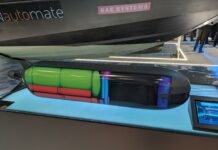Monaco-based surveillance and infrastructure protection specialist MARSS announced at DSEI 2023 on 12 September the launch of a new portable unmanned aerial vehicle (UAV) countermeasure.
Known as the Interceptor-SR (Short Range), the countermeasure is smaller and lighter than MARSS’ larger Interceptor (now known as the Interceptor-MR) and can be used to provide more mobile protection from Class I UAVs.
Like the Interceptor-MR, the Interceptor-SR is a cruciform air vehicle that is launched from a cannister, propelled by four electrically driven propellers, homes onto its target using an infra-red seeker and uses its high manoeuvrability to effect a hit-to-kill solution to hostile incoming UAVs.
While the original Interceptor, launched in 2022, is designed to defeat Class I and II UAVs out to a range of 8 km, the Interceptor-SR is focused on defeating Class I UAVs out to a range of 1 km. Both systems are AI-enabled, autonomous UAV countermeasures that offer an intelligent, cost-effective and low-collateral-damage alternative to short-range missiles for neutralising hostile UAVs.
While the Interceptor-MR would typically be deployed in static launcher batteries to protect bases or critical infrastructure, the deployability of the Interceptor-SR means it can be used on the battlefield to provide effective cover against hostile Class I UAVs and loitering munitions.
Furthermore, a mounted infantry version employs multiple Interceptor-SR launchers that can be integrated onto a range of vehicles, while for dismounted infantry another version is in development, packaged around a re-usable lightweight shoulder launcher with an integrated thermal sight to find and target hostile UAVs when deployed. Once launched, the operator remains ‘over the loop’ to confirm a successful engagement or to abort at any time.
The Interceptors would be integrated with and cued by MARSS’ NiDAR range of surveillance, air defence and command-and-control solutions.
Stephen Scott, head of research and development for defence at MARSS, was quoted by the company as saying, “We developed the Interceptor-SR in direct response to customer demand. When we launched the Interceptor at the inaugural World Defense Show [in Riyadh in March] last year, many customers commented on the need for a portable CUAS solution that mounted and dismounted infantry could successfully use to defeat Category 1 threats at shorter ranges.

“Interceptor-SR is our answer: a mobile solution that’s half the size of our larger Interceptor model, but offers many of the same features. Hostile drones are adapting to the battlefield on a weekly basis and their proliferation will continue beyond current conflicts. We’re always pushing hard to stay ahead of the threat and develop capability in an agile and responsive way for our end users. Interceptor-SR complements the larger Interceptor and offers another air defence layer to protect against these evolving drone threats.”
A MARSS representative explained to ESD at DSEI 2023 that both Interceptors would be available to customers within 12 months and that, in the days just prior to the show, MARSS conducted a successful intercept test in the UK using an Interceptor-MR to destroy a commercial DJI drone.
Peter Felstead












